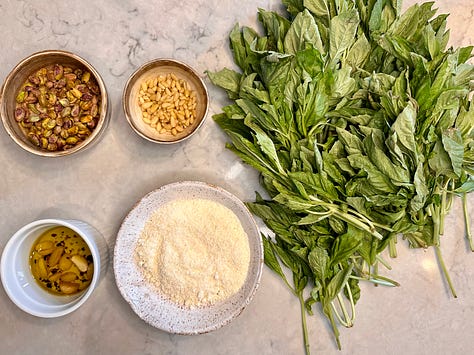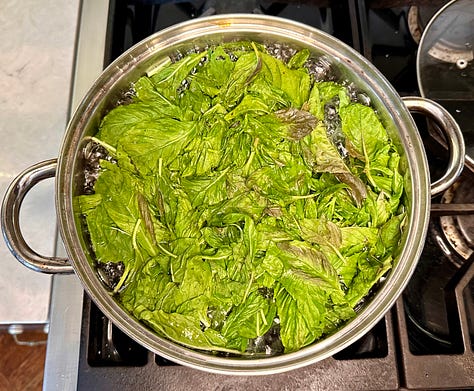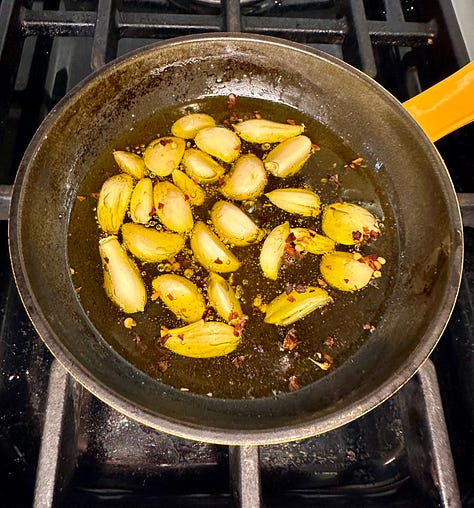I never used to like pesto — it always felt dry to me, overly oily, or simply lacked flavor. But it turns out I had been eating very bad pesto. I want my pasta to be COATED in sauce and what I want in my pesto is for it to be somehow both creamy AND bright. And this, my small but very important group of followers, is what we have here (or at least a version of it because lesbereal pesto can be made one thousand different ways and this just happens to be one of my go-tos).
I’ve been iterating on this recipe for two years now since I found myself in pesto heaven while attending my friend’s wedding in Italy (yes, lucky me). This pesto is a bit nuttier because of the pistachio, but it also means it stays vibrant green. I also have learned to blanch my basil leaves because they never oxidize—more green, more fun.
FINALLY, I have a few picky eaters in my life and one of their pet peeves is raw garlic (I don’t get it, but people feel what they need to feel). One of my favorite parts about this recipe is that I have roasted the garlic (also known as garlic confit to the French) so that the lingering garlic flavor doesn’t attach itself to your tongue and also because, again, lesbereal, roasted garlic is very, very good.



Always Green Pesto
Serves: 5-6
Prep: 30 minutes
Cooking: 10 minutes
Tools:
Food Processor OR blender
Large pot
Small frying pan OR saucepan
Hand-held strainer OR hand-held colander OR spider strainer OR large slotted spoon (whatever will allow you to grab those blanched basil leaves in the boiling water with ease).
Ingredients:
16 oz (1 lb) pasta of choice
4-5 bunches of fresh basil
5 large garlic cloves
¼ cup pine nuts
1 cup shelled roasted pistachios (I prefer these because of the added pepper)
1 cup grated Locatelli pecorino romano
¼ cup olive oil
½ tsp chilli flakes
1 cup pasta water
Salt to taste
Substitutions:
Grated Locatelli pecorino romano → okay fine, if necessary you can use freshly grated parmesan BUT I believe the sharpness of the Locatelli really adds a little ZING to the dish. Whatever you do, do not use the fake grated parmesan cheese by Kraft that’s likely sitting in your Grandma’s refrigerator.
Pine Nuts or Pistachios → Walnuts, roasted cashews, heck — even 1 cup of garbanzo beans could be used to help add to the nutty, creamy flavor necessary for this pesto.
Lemon → less of a substitution and more of a possible add-on. I personally like to add a squeeze of lemon on the pasta after it’s been plated so that the lemon flavor is most vibrant and not cooked down in the sauce.
The Deets:
We first need to roast our garlic, nice and slow, on a low heat. Add your peeled garlic to a small saucepan or frying pan coated in about ¼ cup of olive oil. Hot tip — I always roast more than a recipe asks for because I never know how flavorful my garlic is, sometimes our American garlic is just not packing a punch so — more is more. Depending on the circumference of your pan, you may need to add a bit more olive oil. The hope is that the garlic cloves are completely coated in oil. Add the chili flakes into this mixture and simmer on low heat until your garlic is tender and lightly browned. This should take at least 30 minutes. The slower, the better. I promise.
While your garlic is confit-ing itself, start shelling those pistachios. If you were fancy and bought pre-shelled pistachios, good for you.
Bring large pot of water to a boil. After rinsing off your basil leaves, toss the leaves into the boiling water for 1 minute. No more. We are just blanching our leaves so that they can both remain vibrant green for us and hold onto their delicious basil flavor. Set a timer for yourself and at the 45-second mark begin to take them out because sometimes they swim around and like to get away from you.
Once your garlic has roasted to tender little things, it’s time to get blending. Toss in the blanched basil leaves, pine nuts, shelled pistachios, freshly grated Locatelli pecorino romano into the food processor. If you just have a chunk of Locatelli pecorino that has not been pre-grated, even better, you could toss that chunk in whole. Finally, spoon in your roasted garlic right from the saucepan, including a few spoonfuls of the oil and chilli flakes they’ve been cooking in. The oil from the confit is the only oil you will need for this recipe. I personally don’t want my pesto to be too oily because it will separate, my goal with this recipe is for the sauce to feel creamy, smooth — not an oily separating mess of green flecks.
Anyway, blend the ingredients in your food processor and taste as you go. Depending on the quality of your cheese, it is possible you may not need salt because the 1 cup of grated Locatelli pecorino covers you. BUT, if you taste it and it still isn’t popping the way you want it to, never be scared to add a pinch or two of salt. Salt and taste as you go folks, it is the only way.
Depending on how chunky or smooth you prefer your pesto, blend until the consistency is just right for you. My dear friend who HAPPENS to also make the adorable bowls I feature in these images (follow her new pottery Instagram account here and support a local artisan, yay) prefers her pesto to be texturedddd so that is what I did for her when testing this recipe, but sometimes we also just want it to be silky smooth. Do you.
Finally, bring a large pot of SALTED water to a boil. I tend to use the same exact water I used to blanch the basil. But this must be SALTED because that is what the Italians have told us to do. Once your water is boiling, toss in your noodle of choice. I prefer a rigatoni for most of my sauces because (if it wasn’t already clear) I like having as much sauce as possible trapped in the little tube.
While your pasta is boiling, be sure to taste your pesto one more time. One other thing I tend to play with is how many roasted garlic cloves I add. Some days my garlic is hittin’ after just 5 cloves, sometimes those 5 cloves give me nothing. There is nothing wrong with adding more roasted garlic cloves, in my humble opinion.
WARNING, BEWARE:
DO NOT THROW OUT YOUR PASTA WATER!
While testing this recipe I DID do this and it almost made me cry. That 1 cup of saved pasta water is CRUCIAL because this pesto in particular is a thicc boyyy and you will need that pasta water to help spread its love on your noodles.
Mix together the drained pasta, the pesto, as well as the pasta water until noodles are fully coated. Serve with a squeeze of lemon on top and …. Sahtein!





Yum!!! And YES to always saving pasta water!!!!
On my To Be Cooked list - thank you!!